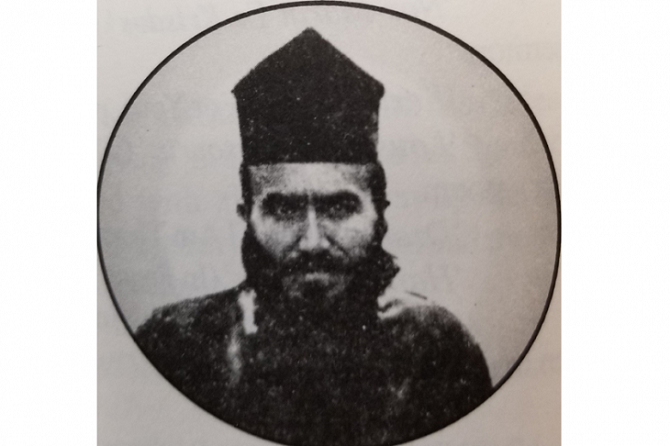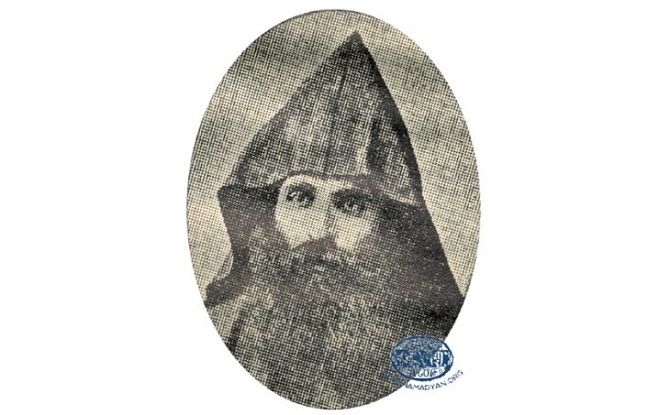ԵՌԱԳՈՅՆ
By Archbishop Papken Tcharian
The series of articles, which will be presented to our readers, are written by Archbishop Papken Tcharian, and translated by Tamar Topjian Der-Ohannessian.
The book, “The Great Loss of the Armenian Clergy during the Armenian Genocide” was published in 2009, by the generous donation of Mr. and Mrs. Levon and Tamar Der-Ohannessian.
The articles which will be featured in the coming days, are from the doctoral thesis of Archbishop Tcharian, and it is dedicated to the 90th anniversary of the martyrs of the Armenian Genocide.
Read also
In his thesis, Tcharian writes, “The enemy, in his cruelty, ruthless and unjust, did not discriminate. He slaughtered the students of Maghakia Ormanian, Yeghishe Tourian and Mekhitar Sepasdatsi, the promising seminarians of Armash and St. Ghazar, who were the true intellectual clergymen, and who shared the fate of their people and their parishes.”
“The catastrophe of April 1915 was a fatal gash in the heart of the Armenian Apostolic Church. Despite of it all, however, the Armenian people and the Armenian Church experienced a new renaissance. … We do not hesitate to call all those clergymen who were massacred during the Genocide of April 1915 martyrs and saints.”
—————————————————
- Rev. Fr. Souren Kalemian was born in Koushna (Arapgir) in 1884. His baptismal name was Boghos. He was a graduate of Armash. He came to Broussa at a young age and attended the French school for cultivating silk-worm. In 1901 he entered the Seminary of Armash and became the student of Arch. Yeghishé Tourian.
In 1905 he was ordained deacon by Arch. Maghakia Ormanian. After completing the curriculum of the seminary, he was ordained celibate priest on May 31st 1909, by Bishop Sdepanos Hovagimian (prelate of Nigomidia), and was renamed Rev. Fr. Souren.
Arch. Maghakia Ormanian has given the following information about him in his autobiography:
…He was a member of the class formed during Tourian’s term. I gave them the rank of deacon. Their ordination to priesthood was performed after my term as patriarch. It was recommended to the prelate of Nigomidia, Hovagimian, to go to the monastery and to ordain them, which he did.
In the book ‘Armashou Tebrevanki 25-amia Hopelianin Aritov’ (On the Occasion of the 25th Anniversary of Armash Seminary), we read some additional information on this subject.
…The three deacons of the seventh grade, whose ordination was delayed due to the federal and national disturbances of 1908, were ordained celibate priests on May 31st 1909 and were renamed:
- Deacon Boghos Kalemian ( V. Rev. Fr. Souren)
- Deacon Vahram Nazaretian ( V. Rev. Fr. Vahram)
- Deacon Kegham Teveklian ( V. Rev. Fr. Kegham)
During the last year of his studies, he collaborated with his classmates and prepared a dissertation, “Bashdoneoutiun Hay Yegeghetsvo” (Personnel of the Armenian Church), which he presented as his thesis.
In 1910 he was assigned to be preacher of St. Garabed (Forerunner) Church in Sgudar. Later, he taught religion in the ‘Azkayin Getronagan Varjaran’ (Central National School) in Ghalatia. In 1910, the editors of the weekly Dadjar wrote in their column titled ‘Azkayin Giank’ (National Life):
We are happy to find out that after the resignation of V. Rev. Fr. Knel, the teaching of religion has been entrusted to V. Rev. Fr. Souren Kalemian, a fellow worker of Dadjar. The young priest from Armash has the enthusiasm typical of his youth, along with a circumspect seriousness and an inquisitive mind so uncharacteristic to his age. The board of the ‘Getronagan’ is to be commended for their choice.
In 1911 he was elected prelate of the diocese of Paghesh by the National Representative Assembly of Paghesh (Bitlis). Immediately after his election and based on the decision of the Religious Council, he received doctorate degree (Dzayrakoun) from Bishop Maghakia Derounian.
On the occasion of V. Rev. Fr. Souren’s election, the editors of Dadjar expressed their joy and made the following greetings:
…The leaders of the community of Paghesh showed a commendable and cognizant attitude by consolidating their votes on His Grace, who is a graduate of Armash and who has the enthusiastic energy of youth along with the seriousness and circumspection of a clergyman. These are traits which our readers have noticed in his writings.
… We wish energy and total success to our colleague in the difficult job he is undertaking. Clergymen like him will be very useful in the province where our suffering people need enthusiastic and selfless, as well as serious and circumspect prelates.
- Rev. Fr. Souren remained as prelate of Paghesh for four years, until 1915, the date of his martyrdom. During the hazardous period in the three years of his tenure he had a far-reaching and productive time. He had barely assumed the office of prelate when he was faced with a treacherous situation. He received news of crime and murder, especially from the region of Khouyt. He made serious requests to the authorities to investigate the situation and to arrest and punish the criminals appropriately. He sent several telegrams to the patriarchate of Constantinople asking for their intervention and to obtain the safety measures needed for the province of Paghesh. Thus, for example, he wrote the following letter to the patriarchate, dated May 31st 1911: “… The governor went to the site of the latest killings with two troops of soldiers. We are waiting for the proper measures to be taken. We have also undertaken investigations on our part. We have put the details about the murders in the mail.” When he heard that the criminals were arrested by the authorities, he sent the following report to the patriarchate: “The governor went to the location of the crime with two troops of soldiers. He arrested the infamous thief Haji Eomer who is now in jail. He has also arrested seven other bandits…”Despite his brave stance during those sad incidents and his stern messages, V. Rev. Fr. Souren was able to develop friendly relations with high-placed government officials and responsible employees and commanded their respect. He also worked relentlessly to organize the schools. He invited talented teachers from Constantinople, and most importantly, he improved the budget of the schools. He revived the four monasteries in the province of Paghesh, and helped them flourish. He made a great impression on the people. The four monasteries were: ‘Amrdolou (Amlortvo) St. Hovhannes’ which was in the city, as well as ‘Komats’, ‘Avekhou’ and ‘Khentragadar’ which were christened Holy Asdvadzadzin (Mother of God).
In their 1911 edition, the editorial staff of the Dadjar weekly wrote with satisfaction in the column titled ‘Azkayin Gianke’ (The National Life) about the diocesan activities of V. Rev. Fr. Souren, based on various letters sent to them:
…Letters we have received speak highly about the diocesan work done by the young Armash graduate. He had barely assumed his office when he came face to face with the appalling crime in Khouyt, and the reports and telegrams he sent to the patriarchate can be considered as criteria of his work. Despite the bold stand he took on this issue, V. Rev. Fr. Souren was able to establish very cordial relations with the highly placed officials of the local government, which, we are certain is no mean feat for securing the well-being of his people. On the other hand, he was able to leave a deep impression on the Armenian people and inspired their respect. Education being a priority for him, he has united the schools, has put together a fine budget, and has invited teachers from Constantinople. He has also united the four monasteries, which has left a very good impression. These are satisfactory reports, and we are certain that after establishing their veracity, the Executive Council will encourage him, inspiring in him more enthusiasm and passion. It is desirable that all the young, fresh and cultivated elements of the Armenian clergy willingly devote themselves to comfort the deep suffering of the people in the provinces.
In 1914 he received a certificate for episcopal ordination from the National Representative Assembly of Paghesh, as an appreciation of his altruistic devotion. But he did not have the good-fortune to attain that high rank because of the unexpected onset of the treacherous incidents. He was deported with his people and martyred.
The good news of his receiving the certificate was reported in the 1914 edition of the weekly Dadjar:
…The Representative Assembly of Paghesh has given a Bishop’s certificate to the prelate, V. Rev. Fr. Souren, for his devoted work during the three years of crisis. That certificate has been sent to the Central Executive Council for endorsement. A reporter wrote: “… In addition to the achievements in establishing the security of his parish, V. Rev. Fr. Souren has also been instrumental in the advancement of the educational program. While previously there were only six schools in 73 villages, he was able to increase that number to forty-one. He was able to build a beautiful building in the city, which has an annual income of fifty-seven Ottoman gold-coins. On the other hand, despite his very firm requests, he was still able to inspire the respect of the government and to establish a cordial relationship with it.
With the declaration of the First World War, the Turkish government ordered military conscription in August of 1914. The Armenian youth of Paghesh, men 20-50 years of age went to serve. The Armenian population of Paghesh also complied with loyalty and placed all its wealth at the service of the Turkish government. The patriarch of Constantinople, Arch. Zaven Yeghiayan, acting upon the decision of the Joint Assembly, distributed flyers urging everyone “to be vigilant and to help and abet the Ottoman Government, to undertake all kinds of sacrifice for the ultimate good of the fatherland and to promote good relations with our non-Armenian neighbors. In addition to financial aid, we must advise the people, no matter how unfamiliar they might be with military life, not to spare their lives, if the fatherland needs it. Thus the Armenians have to remain loyal to the Ottoman government.”Despite all that, the Turkish government started implementing its plan of annihilating the Armenians, accusing them of disloyalty to the government.
The prelate of Paghesh, V. Rev. Fr. Souren, wrote the following to the patriarch of Constantinople, Archbishop Zaven Yeghiayan, on October 13th 1914, in his letter No. 128:
On the 8th of this month we received a letter from the prelacy of Garin, whereby we were informed that there was a rumor in the local government circles of Garin alleging that Armenian armed bands had formed ‘chetes’ and were attacking Moslem villages.
These rumors have become a pretext in the hands of the local authorities to treat the Armenians with distrust, and as Bishop Sempad (Saadetian) has written in the mentioned letter, more than a hundred Armenians have been arrested in the regions of Garin and Pasen. These rumors caught us by surprise, because until now there have never been ‘chetes’, attacks, etc. in our diocese. On the contrary, like everywhere else, Armenians in our diocese have not spared their lives and possessions, and will never do so, for the service of the government, with the utter loyalty of a citizen.
We explained the absolute deceitfulness of this news and the loyalty of the Armenians, giving pertinent proof, and asked Bishop Sempad to translate our letter and to talk to whom it may concern.
The bishop mentioned in our letter that more than 250 Armenian soldiers had crossed over from Van to Russia with their weapons. Our prelacy, especially in today’s circumstances, is in constant contact with our neighboring prelacies, such as Van, and we have no information, official or unofficial, about this incident. Therefore we informed the Bishop that this news was false.
With a second letter bearing the same date, V. Rev. Fr. Souren wrote to the patriarchate of Constantinople on the same subject. In the letter, he first reported that three policemen were killed in Mush, and the killers were Armenians. The governor of Paghesh went to Mush to arrest and punish the criminals. When the governor returned to Paghesh V. Rev. Fr. Souren met with him and had a lengthy conversation regarding this incident.
“Upon the governor’s return from Mush, and at his special invitation, we had a long meeting. Despite our insistence that the crime was the act of a few, and that one must not generalize such events, and despite all kinds of attestations that the Armenians were since the beginning citizens loyal to the government, we are sorry to say that our governor, who had attained his office by luck and not by merit, wanted by sheer spitefulness to depict all the Armenians to be disloyal.”
The Turkish government was preparing for the implementation of Genocide on all levels. First, it tried to exterminate the strong armed forces. All the young men who were in military service were decimated brutally by ruthless Turkish and Kurdish soldiers. Survivors of the calamity in Paghesh wrote:
When the World War was declared, all the Armenian young men aged 21-45 were drafted into the army, disregarding the restrictions of age, and the pleas of the sick and the disabled. When the Turkish-Russian confrontations started, they were all sent to the front and were systematically massacred. Those not hit in the head by a bullet, were delivered to the Turkish soldiers, who took them a half-hour distance from the army and massacred them.
… Thus it continued destroying the whole armed Armenian youth. ‘Chete’ bands were formed from the bloodthirsty criminals of the Turkish and Kurdish people, and those who joined were given clemency from old and new indictments and from military service. The Turks rushed to participate in these groups, who would eventually destroy the homes of the Armenians.
In the beginning of June of 1915 the number of arrests increased gradually and by the end of the same month groups of 700 persons chained together were taken about one hour’s distance from the city, to the valleys and gardens of Altoun Khalber and Tashkhonts Sefer, to be looted, skinned and axed to death by Turkish policemen.
The governor of Paghesh, Moustafa Abdul-Khalif Bey, was the chief organizer of this massacre. He gave a speech in the presence of Tukish notables and stressed the necessity of the total eradication of the Armenians in the provinces, for the future security of Turkey.
Teotig has described the ferocity of the governor of Paghesh, Abdul-Khalif in a poignant report:
…The governor was Abdul-Khalif, and the brutality of his acts has no limits. The Armenians in the city and the more than seventy neighboring villages are completely annihilated, mostly in a location called ‘Arabi Garmounj’, about one hour away from the city. The women have been raped, the men clubbed, stabbed and axed to death, the children drowned in the river, and the officers of the church were subjected to unspeakable torture before being martyred.
On June 22nd 1915, the same governor, Mustafa Abdul-Khalif, invited the young and active prelate of Paghesh, the pastor of the Evangelical church, Rev. Vartanian, and the activist, Armenag Tsokhigian, for a consultation and to investigate the situation. But when they arrived there, they realized that they were going to their deaths. And indeed, after a short time they were arrested and martyred.
This was the life, career and martyrdom of the young and passionate prelate, V. Rev. Fr. Souren.
***
- Rev. Fr. Souren Kalemian was a writer. A number of his articles and sermons have reached us. During his very short lifetime, he was very productive both as a clergyman and as an intellectual.
He contributed to the various contemporary publications of Constantinople, especially to the weeklies, Louys and Dadjar.
HIS ARTICLES AND SERMONS:
- ‘Vor Orhnes Zaynosig’ (You Bless Those), poem, written in Sgudar.
- ‘Hisous yev Avedarani Karouzoutiune’ (Jesus and Preaching the Gospel) gathered from Edmond Stapler’s book, ‘La Palestine’.
- ‘Asdoudzo Tsayne’ (God’s Voice), poem (translation).
- ‘Pergoutian Avedarane’ (The Gospel of Salvation), editorial sermon.
- ‘Ashoune’ (The Autumn), poem (translation).
- ‘Asdvadzashountchin Aztetsoutiune’ (The Influence of the Bible), editorial sermon.
- ‘Bardez, Khatch, Kerezman’ (Garden, Cross, Tomb), editorial sermon.
- ‘Kidoutiun yev Havadk’ (Science and Faith), sermon.
- ‘Artaroutian Dzenounte’ (The Birth of Justice), sermon.
- ‘Asdvadz Im’ (My God…), sermon.
- From the Bible, ‘Yergou Kouyrere’ (The Two Sisters), exegesis.
- ‘Kaghdni Tsayner’ (Secret Voices), poem (translation).
- ‘Herovtiayi Zohe’ (The Victim of Herodia), exegesis.
- ‘Katchaleritch Desaran’ (An Encouraging Scene), poem (translation).
- ‘Sires Zis?’ (Do You Love Me?), exegesis.
- ‘Arevod Verargoun’ (The Sunny Coat), written in remembrance of a death.
- ‘Tashginagé Badanke’ (The Linen Shroud), a heart-wrenching scene, written in Paghesh.
- ‘Eser…’ (I Wish He Said…), poem dedicated to the memory of a friend.
- ‘Giank yev Artsounk’ (Life and Tears), article written in Paghesh, where he has analysed life and has expressed his most touching feelings.
- ‘Dziadzane yev Atore’ (The Rainbow and the Chair), exegesis, excerpts from the Bible.
- ‘Dzovapi Aghotouhin’ (The Lady Praying on the Shore). A sad portrait from the homeland, written in Paghesh.
- ‘Ariunod Djashe’ (Bloodied Meal), an article.
- ‘Oukhdavor Gine’ (The Pilgrim Woman), an article.
- ‘Pagheshi Zemrout Avedarane’ (The Zemrout Gospel of Paghesh).
- ‘Voghchagizvadz Gouyse’ (The Sacrificed Maiden).
- ‘Lousanegarin Archev’ (In Front of the Photograph), an article.
- ‘Yegeghetsagan Badmoutiun’ (Church History), an article. (The social traditional life in the Fourth Century, under the influence of Christianity). Signed, Boghos Sargavak, and written in the seminary.
- ‘Mahe yev Hantertsial Gianke’ (Death and the Life to Come), translation, signed Boghos Sargavak Kalemian.
- ‘Hisousi Gianki Kelkhavor Tvagannere’ (The major dates in Jesus’ life). Translation signed Boghos Sargavak Kalemian.



























































